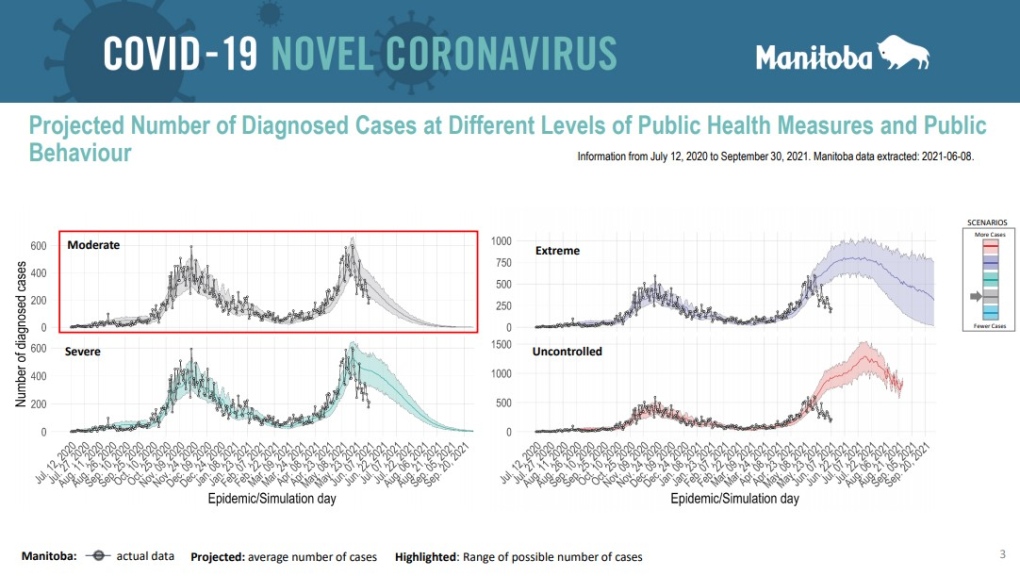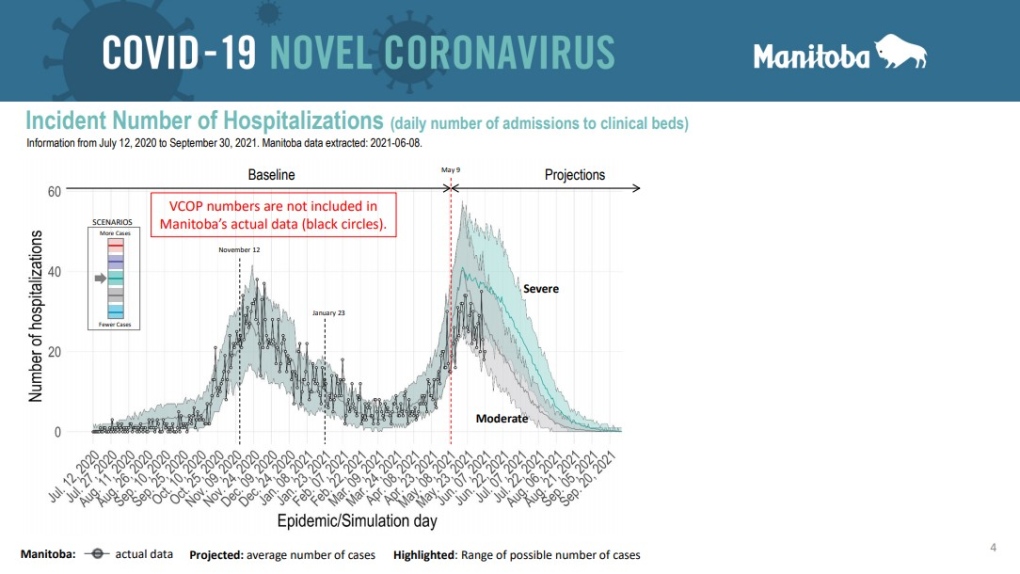Manitoba modelling shows COVID-19 cases dropping through summer, severe outcomes remain high
New modelling data released by the province shows daily COVID-19 tests are dropping and will continue to drop through the summer, but severe outcomes will remain high for the next few weeks.
Manitoba public health released the modelling data on Friday, giving Manitobans a glimpse at what their summer may look like.
The data – which has projections to the end of September – shows Manitoba's current daily COVID-19 cases are under the moderate scenario and decreasing.
 (Source: Province of Manitoba)
(Source: Province of Manitoba)
"This indicates the restrictions have been in place, and the adherence to those restrictions by the public helped reduce the spread of the virus in Manitoba – this is why we have been able to begin easing restrictions and begin charting a path to reopening," Dr. Jazz Atwal, the deputy chief provincial health officer, said on Friday.
Modelling data released in mid-May showed Manitoba was dealing with the worst-case scenario.
Now, nearly a month later – and with weeks of tighter restrictions at play – the outlook isn’t as dire.
"Our case numbers are headed in a good direction, and our vaccination rates are increasing, but we continue to see strain on our health-care system, and we continue to transfer patients out of the province for care."
 (Source: Province of Manitoba)
(Source: Province of Manitoba)
Atwal said despite case numbers coming down in Manitoba, a high number of severe outcomes will continue over the next weeks as case counts and test positivity rates are still high.
"Severe outcomes tend to occur one to two weeks after diagnosis," Atwal said.
Hospitalizations are projected to remain in the severe scenario for the next few weeks.
The province is looking at both severe and extreme scenarios for ICU admissions as dozens of patients continue to receive care outside of the province.
Epidemiologist Cynthia Carr said the national median length of stay in hospital is as high as 14 days for the oldest population.
“People can still be in the ICU even after the virus is not detectable because that is how serious the impact is on our respiratory system, our circulation, our cerebral vascular system," she said.
"This virus attacks the body from head to toe.”
Atwal said the modelling doesn’t take into account the more transmissible delta variant as of yet.
“There is no screen yet for the delta or the kappa variant. Those are being developed, but if a positive test result doesn’t screen in for the alpha, beta, or gamma variant, those are automatically sequenced.”
The modelling also shows the daily number of COVID-19 tests has decreased and is now below projected levels.
Atwal noted this is likely related to the virus circulating less because of restrictions and adherence to the restrictions.
You can see the full modelling data here:
CTVNews.ca Top Stories

BREAKING American millionaire Jonathan Lehrer denied bail after being charged with killing Canadian couple
American millionaire Jonathan Lehrer, one of two men charged in the killings of a Canadian couple in Dominica, has been denied bail.
Grandparent scam suspects had ties to Italian organized crime, Ontario police allege
A group of suspects that allegedly defrauded seniors across Ontario and other parts of Canada using a so-called emergency grandparent scam appear to have ties to 'Italian traditional organized crime,' according to an investigator involved in the OPP-led probe.
Motion to allow keffiyehs at Ontario legislature fails
A motion to reverse a ban on the keffiyeh within Queen’s Park failed to receive unanimous consent Thursday just moments after Ontario Premier Doug Ford reiterated his view that prohibiting the garment in the House is divisive.
Trend Line Anger, pessimism towards federal government reach six-year high: Nanos survey
Most Canadians in March reported feeling angry or pessimistic towards the federal government than at any point in the last six years, according to a survey by Nanos Research.
Lack of detention space could force CBSA to release detainees, internal memo warns
The Canada Border Services Agency is scrambling to find space to hold high-risk detainees that are set to be transferred from provincial jails in June.
BREAKING Allman Brothers Band co-founder and legendary guitarist Dickey Betts dies at 80
Guitar legend Dickey Betts, who co-founded the Allman Brothers Band and wrote their biggest hit, 'Ramblin' Man,' has died. He was 80.
Taylor Swift's new album allegedly 'leaked' on social media and it's causing a frenzy
A Google Drive link allegedly containing 17 tracks that are purportedly from Swift's eagerly awaited "The Tortured Poets Department" album has been making the rounds on the internet in the past day and people are equal parts mad, sad and happy about it.
What does it mean to be 'house poor' and how can you avoid it?
The journey to home ownership can be exciting, but personal finance columnist Christopher Liew warns about the trappings of becoming 'house poor' -- where an overwhelming portion of your income is devoured by housing costs. Liew offers some practical strategies to maintain better financial health while owning a home.
Calgary man charged with manslaughter in death of toddler
Calgary police say Winston Campbell, 45, has been charged in the death of a two-year-old girl in 2022.
































